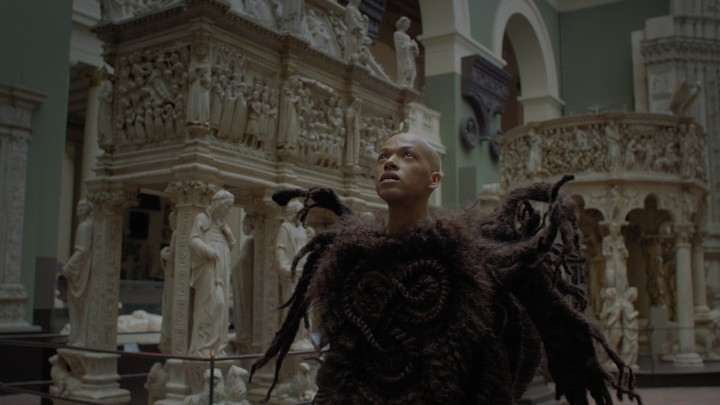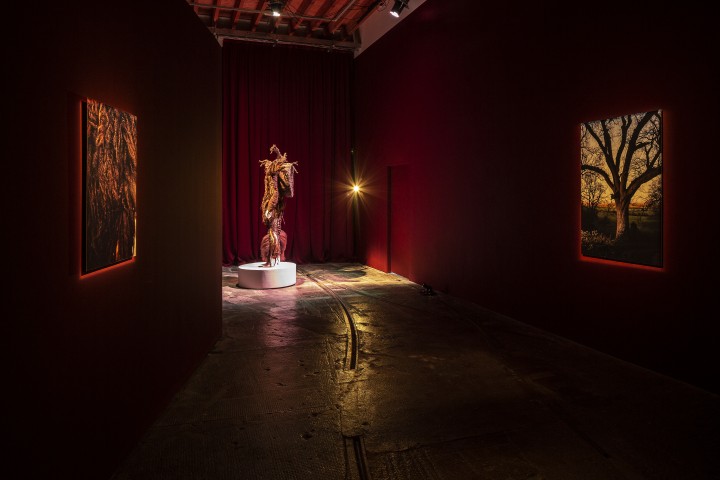Scottish Art News
Latest news
Magazine
News & Press
Publications
A Field in England
By Greg Thomas, 22.12.2021

Amartey Golding’s new show of film and photography fuses Rastafarian, Celtic, and West-African cultural references, offering a potent origin myth for modern Britons. Greg Thomas digs through the work at Tramway.
The first scene of the film that serves as the centrepiece for Amartey Golding’s Bring Me To Heal shows a field lit by a fiery sunset, a gnarled tree silhouetted against the evening sky. It’s like something from the weird-Albion iconography of Ben Wheatley—an homage to the eerie, eldritch aspects of the English countryside. A fire is kindled by a group of nomadic storytellers, one of whom embarks on a tale called “The Horse and the Goose,” somewhere between one of Aesop’s fables and the human-animal metamorphoses of origin myths from across the world.
In the story, a white horse runs wild across the surface of the planet, trampling over and destroying all the flora and fauna it encounters, carrying with it a goose inadvertently caught up in its mane. The horse’s limbs beg it to slow down, and when the animal refuses they drop off, eventually leaving only its head lolling helplessly in the dirt. The kind-hearted goose realises that the horse had only been charging so furiously “because he was so very afraid,” and scoops up what is left of him “before his fear could soak into the ground.” In a moral denouement characteristic of the genre, the other animals of the earth begin to thrive, while the goose teaches his new companion “everything he knew about the beauty of the world and the origin of all the animals.”
 Amartey Golding, Bring Me To Heal, video still. Courtesy the artist.
Amartey Golding, Bring Me To Heal, video still. Courtesy the artist.
What we have heard is, of course, an analogy for the centuries of pillage and plunder that defined the relationship between Christian Europe and the rest of the world. The message of the fable is borne out in the second part of the film, when a character brought to life by the nomad’s tale, wearing an elaborate suit of human hair– crafted by Golding in collaboration with hair artist Kevin Fortune and modelled by the artist’s brother – is spirited to the V&A in London. There he encounters the beauty and brutality of western culture through the artworks on display (one shot finds him eying a cast of Michelangelo’s David warily) and is ultimately brought to weeping.
The British art scene is not short of photographers and filmmakers dealing with the vexing legacies of imperialism (and with good reason). But what’s striking about Golding’s approach is that the audience he is hoping to nurture and lift up through his work – rather than simply educate or cut down to size – encompasses the descendants of the coloniser as well as their subjects. His work is presented as “a collective ritual of healing,” with the implication that dialogue, forgiveness, and attention to the nuances of identity are as vital as the airing of grievance – however legitimate – in coming to terms with Britain’s blood-steeped social contract. Indeed, the film-maker and photographer has spoken of his desire to connect with his own white heritage by creating this show (he was born in London in 1988 to an Anglo-Scottish mother, Ghanaian father, and Jamaican stepfather).
 Amartey Golding, Bring Me To Heal, installation shot at Tramway. Image Keith Hunter.
Amartey Golding, Bring Me To Heal, installation shot at Tramway. Image Keith Hunter.
If the conceptual and emotional heart of Bring Me To Heal is the two-screen film-work just described, its visual and atmospheric crux is the extraordinary hair suit featured in that story, which is also on display as a standalone artwork, illuminated by a single spotlight. (Tramway’s front windows have been covered to create a moody near-pitch-black setting, with photographs of the garmented mythical figure backlit along the walls.) The ornate robe features a pattern blending references to Afro-hairstyles with the body art of ancient Britons. Close braiding forms intricate loops and swirls around the chest and legs, while magnificent antler-like shoulder-appendages equally suggest the twisted trunks and branches of an oak, returning us to the imagery of the film. “Using the hair of potentially thousands of people,” the curators state, “each strand was hand knotted and tended to by a group of makers.” Looming above the viewer on its squat plinth, the robe seems to fizz with animate energy, a fitting talisman for a show whose deliciously gloomy atmospherics are as memorable as its message of healing.
Amartey Golding: Bring Me to Heal is showing at Tramway, Glasgow, until 27th February 2022. It will tour to 198 Contemporary Arts & Learning, London, from 17th March until 1st May 2022.




